儿童泌尿系统疾病-2018.10
儿童常见的泌系统疾病及其防治措施
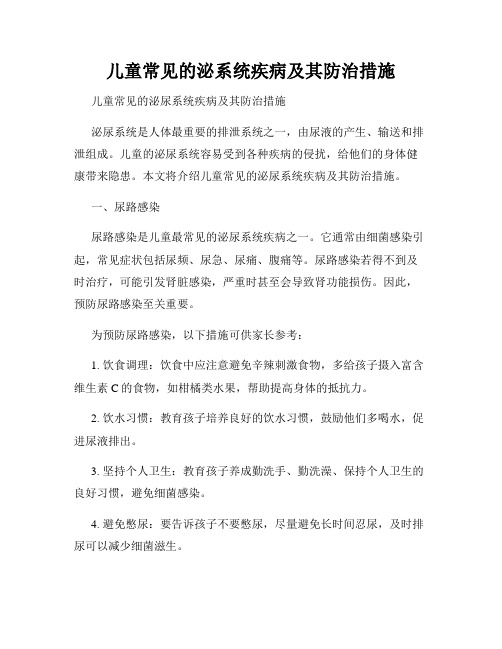
儿童常见的泌系统疾病及其防治措施儿童常见的泌尿系统疾病及其防治措施泌尿系统是人体最重要的排泄系统之一,由尿液的产生、输送和排泄组成。
儿童的泌尿系统容易受到各种疾病的侵扰,给他们的身体健康带来隐患。
本文将介绍儿童常见的泌尿系统疾病及其防治措施。
一、尿路感染尿路感染是儿童最常见的泌尿系统疾病之一。
它通常由细菌感染引起,常见症状包括尿频、尿急、尿痛、腹痛等。
尿路感染若得不到及时治疗,可能引发肾脏感染,严重时甚至会导致肾功能损伤。
因此,预防尿路感染至关重要。
为预防尿路感染,以下措施可供家长参考:1. 饮食调理:饮食中应注意避免辛辣刺激食物,多给孩子摄入富含维生素C的食物,如柑橘类水果,帮助提高身体的抵抗力。
2. 饮水习惯:教育孩子培养良好的饮水习惯,鼓励他们多喝水,促进尿液排出。
3. 坚持个人卫生:教育孩子养成勤洗手、勤洗澡、保持个人卫生的良好习惯,避免细菌感染。
4. 避免憋尿:要告诉孩子不要憋尿,尽量避免长时间忍尿,及时排尿可以减少细菌滋生。
5. 合理穿衣:孩子需要适度穿衣,尤其是在寒冷的天气中,避免盲目追求时尚,减少感冒引发的尿路感染风险。
二、尿路结石尿路结石是儿童的另一种常见泌尿系统疾病。
结石可以发生在肾脏、输尿管以及膀胱等部位,影响泌尿系统的正常排尿功能。
儿童若患有尿路结石,可以通过以下方法加以预防和治疗:1. 增加水分摄入:鼓励孩子多喝水,保持充足的尿液排出,有助于流动性好的尿液将结石冲刷出体外。
2. 控制饮食:减少摄入富含钙、草酸盐的食物,如奶制品、巧克力等,以减少结石形成的风险。
3. 药物治疗:结石较小的孩子可以采取药物治疗的方法,例如使用针对结石溶解的药物。
4. 手术治疗:对于较大且无法通过药物溶解的结石,可能需要进行手术治疗。
家长应咨询医生,了解最适合孩子的治疗方案。
三、遗尿症遗尿症是指超过5岁的儿童仍然持续夜间遗尿。
这种情况可能由多种原因引起,如尿液过多、夜间尿液过多、膀胱容量小或者膀胱功能障碍等。
小儿泌尿系统疾病第一节课件
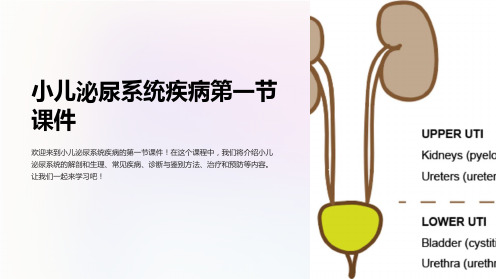
欢迎来到小儿泌尿系统疾病的第一节课件!在这个课程中,我们将介绍小儿 泌尿系统的解剖和生理、常见疾病、诊断与鉴别方法、治疗和预防等内容。 让我们一起来学习吧!
小儿泌尿系统
解剖和生理
了解小儿泌尿系统的结构 和功能对于诊断和治疗疾 病至关重要。
常见疾病
探讨小儿泌尿系统的常见 疾病,包括尿路感染、泌 尿系统先天畸形等。
下一步行动
提供进一步学习和了解小 儿泌尿系统疾病的资源, 以便更好地为患儿提供帮 助。
参考文献
列出本节课所使用的参考 文献,便于学员进一步深 入学习。
病因和流行病学
了解小儿泌尿系统疾病的 病因和流行病学特点,有 助于更好地预防和治疗。
疾病诊断与鉴别
1
临床表现和病史询问
学习如何通过观察症状和询问病史来初步判断小儿泌尿系统疾病的可能性。
2
体格检查和常用实验室检查
了解进行体格检查和常规实验室检查的步骤和方法,以及如何解读结果。
3
影像学和生物组织检查
介绍常用的影像学和生物组织检查技术,以及它们在小儿泌尿系统疾病鉴别诊断 中的应用。
治疗和预防
药物治疗
手术治疗
探讨小儿泌尿系统疾病的药物 治疗方法,帮助患儿恢复健康。
了解哪些小儿泌尿系统疾病需 要手术治疗,并了解手术的过 统疾病的 方法,包括保持良好的卫生习 惯和健康饮食。
结论
小结和总结
回顾本节课所学内容,总 结小儿泌尿系统疾病的特 点和治疗方法。
儿科泌尿系统疾病—泌尿系统疾病概述(儿科学课件)

<300
<50
800-1400
<400
三、儿童排尿情况及尿液特点
尿液性质 • 正常小儿的尿液为淡黄色、透明 • 生后前几天尿液颜色深,数日后尿色变浅 • 婴幼儿在寒冷季节,尿液放置后呈乳白色,可与乳糜尿 鉴别
三、儿童排尿情况及尿液特点
尿液检查 • 尿渗透压
新生儿:240mmol/L,1岁接近成年人 • 尿比重
尿液检查 • 12小时尿沉渣计数(Addis计数)
红细胞<50万 白细胞<100万 管型<5000个
儿童肾小球疾病的临床分类
一、原发性肾小球疾病
1.肾小球肾炎 • 急性肾小球肾炎 • 急进性肾小球肾炎 • 迁延性肾小球肾炎 • 慢性肾小球肾炎 2.肾病综合征 3.孤立性血尿和蛋白尿
二、继发性肾小球疾病
肾小球滤过率(GFR) • 新生儿GFR比较低,早产儿更低 • 生后一周为成人的1/4 • 6-12个月为成人的3/4 • 2岁达成人水平
二、生理特点
GFR低的原因 • 新生儿肾小球滤过面积小 • 心搏出量少,动脉血压低,肾灌注不足 • 入球和出球小动脉阻力高 • 肾小球毛细血管通透性低
二、生理特点
儿童泌尿系统解剖生理特点
一、解剖特点
肾脏(kidney) : 1. 重量:小儿年龄愈小,肾脏相对愈重; 2. 位置:肾脏位置低,2岁以内健康小儿腹部触诊时可扪及。
输尿管(ureter): 1.长而弯曲,管壁肌肉和弹力纤维发育不良 2.与膀胱连接部的结构发育不成熟
一、解剖特点
膀胱(bladder) : 婴儿膀胱位置比年长儿高,尿液充盈时,膀胱易顶入腹
酸碱平衡 新生儿及婴幼儿易发生酸中毒
• 肾脏保留HCO3-能力差,碳酸氢盐的肾阈低 • 肾小管产NH3和H+能力低 • 尿中排磷酸盐量少
儿童泌尿系统疾病教育课件

膀胱炎:儿童膀胱炎的发病率较低,但可能引起尿频、尿急、尿痛等症状
尿道炎:儿童尿道炎的发病率较低,但可能引起尿频、尿急、尿痛等症状
儿童泌尿系统疾病预防与保健
05
保持卫生习惯
避免接触感染源:避免接触生病的人或动物,避免去人多的地方
勤洗手:饭前便后、接触公共物品后都要洗手
儿童泌尿系统疾病教育课件
添加文档副标题
汇报人:XX
目录
02
课件介绍
06
儿童泌尿系统疾病治疗与护理
01
单击添加目录项标题
03
泌尿系统基础知识
04
儿童泌尿系统常见疾病
05
儿童泌尿系统疾病预防与保健
添加章节标题
01
课件介绍
02
课件背景
儿童泌尿系统疾病的预防和护理非常重要
课件旨在帮助家长和教师了解儿童泌尿系统疾病的相关知识,以便更好地预防和护理
手术治疗:对于严重的泌尿系统疾病,可能需要进行手术治疗
饮食调整:调整饮食结构,增加水分摄入,减少刺激性食物摄入
生活习惯调整:保持良好的生活习惯,如定时排尿、避免憋尿等
治疗过程及注意事项
注意事项:遵医嘱、按时服药、定期复查、保持良好的生活习惯等
治疗原则:早发现、早治疗、早康复
治疗方法:药物治疗、手术治疗、物理治疗等
感谢指正
汇报人:XX
关爱方式:通过游戏、故事、音乐等方式,缓解患儿的紧张情绪
社会支持:加强社会对儿童泌尿系统疾病的关注和关爱,提供更多的支持和帮助
儿童泌尿系统疾病案例分析
07
典型案例介绍
症状:尿频、尿急、尿痛治疗方法:抗生素治疗
小儿泌尿系统疾病总论课件

04
小儿泌尿系统疾病的诊断方法
病史采集和体格检查
病史采集
详细了解患儿的病史,包括症状出现 的时间、病情变化、家族史等,有助 于医生判断病因和制定治疗方案。
体格检查
对患儿进行全面的体格检查,包括体 温、脉搏、呼吸、血压等生命体征, 以及腹部、泌尿生殖系统等部位的触 诊和观察,有助于发现异常体征。
实验室检查和尿液分析
,帮助患儿建立健康的生活方式。
06
小儿泌尿系统疾病的预防和保健
保持卫生和预防感染
01
02
03
勤洗手
教育孩子养成勤洗手的好 习惯,尤其是在上厕所、 更换尿布后,以减少细菌 进入尿道的机会。
清洁会阴部
每次便后,家长应帮助孩 子清洁会阴部,避免粪便 和尿液残留,引发感染。
避免交叉感染
尽量避免与其他孩子共用 毛巾和洗浴用品,以防交 叉感染。
02
小儿泌尿系统的基本知识
泌尿系统的结构和功能
泌尿系统由肾、输尿管、膀胱和尿道 组成,主要功能是生成和排泄尿液。
输尿管将尿液从肾输送到膀胱,膀胱 储存尿液,尿道将尿液排出体外。
肾是泌尿系统的核心器官,负责过滤 血液,排除废物和多余水分,形成尿 液。
小儿泌尿系统的特点
小儿泌尿系统的结构 和功能尚未完全发育 成熟,与成人存在差 异。
背景
随着医学的进步,小儿泌尿系统疾病的诊疗水平不断提高,但仍然存在许多挑 战和问题。因此,对于小儿泌尿系统疾病的深入研究和学习是十分必要的。
定义和范围
定义
小儿泌尿系统疾病是指发生在儿童泌尿系统的一系列疾病的 总称,包括肾、输尿管、膀胱、尿道等部位的疾病。
范围
本课件涵盖了小儿泌尿系统疾病的各个方面,包括但不限于 肾小球肾炎、肾病综合征、泌尿系感染、肾结石等常见疾病 ,同时也介绍了少见和罕见疾病。
小儿泌尿系统疾病PPT课件
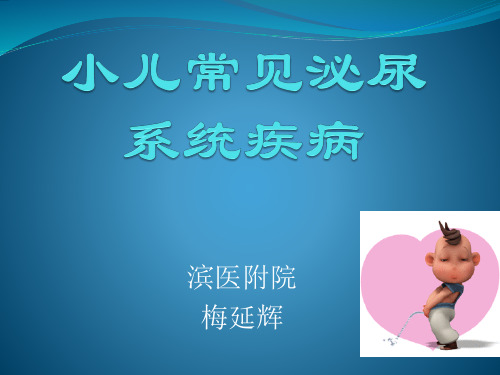
手术治疗
1.开放性肾盂输尿管成形术
2.腔内肾盂输尿管成形术 ①腹腔镜肾盂裁剪成形术; ②经皮肾穿刺肾盂内切开术; ③输尿管镜肾盂内切开术; ④气囊扩张术。
术后注意事项
注意保护好相关管路避免脱出
瘢痕包茎15其他建议手术情况最佳年龄建议57岁16有以下情况包皮不能手术尿道下裂17手术的问题恢复需要多长时间18两种手术方法比较出血量510ml02ml术后外观满意满意对生活影响有影响影响很大手术时间3040分钟510分钟术后护理适度护理护理更麻烦费用低廉高昂19术后困惑龟头分泌物堵塞尿道口是否需术中留置尿管
尿道下裂
手术的问题
手术安全吗 麻醉的问题 手术时间选择 恢复需要多长时间
两种手术方法比较
手术方式 环切
环扎
出血量 术后外观
5-10ml 满意
0-2ml 满意
对生活影响 有影响
影响很大
手术时间 术后护理
30-40分钟 5-10分钟 适度护理 护理更麻烦
费用
低廉
高昂
术后困惑
龟头分泌物堵塞尿道口
临床表现及查体
交通性鞘膜积液:积液量与体位有关,平卧位积液量减 少或消失,站立位时增多,可触及睾丸和附睾,ห้องสมุดไป่ตู้光试 验阳性。若鞘状突与腹腔的通道较大,场管或大网膜可 进入鞘膜突出现腹股沟斜疝。
诊断及鉴别诊断
查体及彩超检查多能确诊
鉴别:腹股沟斜疝、附睾炎
治疗
1.随访观察:适用于病程缓慢、积液少、张力小、长 期不增长而无明显症状者。婴儿型鞘膜积液常在2岁前 自行消失,不急于进行治疗。
(3)自体睾丸移植 适用于高位隐睾。不推荐作为常 规手术方式。
儿童泌尿系统疾病

儿童泌尿系统疾病是指影响儿童肾脏、尿路、泌尿生殖系统健康的各种疾病。
极其常见,包括尿路感染、尿失禁、水肿、肾炎、肾病、泌尿系结石等等。
它们对儿童身心健康的发展都有不良影响,因此越早发现和处理,对儿童的健康也越好。
本文将对几种常见的的病因、症状、治疗等方面进行介绍与探讨。
一、尿路感染尿路感染是指由细菌或病毒感染引起的泌尿系统疾病。
尿路感染在儿童中十分常见,因为儿童的泌尿系统还不完善,很容易受到感染。
女孩比男孩更容易得到尿路感染,因为她们的尿道比男孩短,更容易感染。
尿路感染的症状包括尿频、尿急、尿痛、腹痛、发热等。
感染严重时还会出现呕吐、腰痛等症状。
孩子尿频尿急、尿痛时要及时带孩子去医院检查,因为如果不及时治疗,感染可能会造成肾炎、尿闭等严重后果。
治疗尿路感染的方法包括药物治疗和生活习惯上的改变。
孩子需要多多饮水,避免便秘,不过量奶制品等容易引起尿路感染的食品。
药物治疗方面,一般医生会根据病情、年龄、身体状况等因素来开具抗生素给孩子服用。
治疗时应严格按照医生开的药品用量和频率服药,以确保治疗效果和避免副作用。
二、尿失禁尿失禁指的是孩子控制不住自己的小便,尿湿了内衣、裤子等的情况。
尿失禁常常是因为尿道或膀胱的肌肉功能不良,导致孩子没办法自己控制排尿。
尿失禁发生率在5岁以下为5%,在10岁以下为1%。
男孩比女孩更容易得到尿失禁。
尿失禁的原因有很多,包括先天性畸形、短暂性尿失禁等等。
治疗尿失禁的方法包括药物治疗和行为治疗。
药物治疗方面,药品的种类和治疗方法可能因个体情况而有所不同,孩子们通常需要服用抗抑郁药、抗结肠炎药等药物。
行为治疗方面,孩子们需要学会控制排尿,建立规律的排尿习惯,如定时运动训练、详细的排尿日记等。
治疗效果会随着孩子的年龄、身体状况以及治疗方法的不同而有所差异,因此家长们需要给孩子足够的耐心和支持。
三、肾脏肿瘤肾脏肿瘤是指肾脏内部形成的病变,其中包括儿童中最常见的肾母细胞瘤,这是一种恶性肿瘤,发病率在0-5岁的儿童中最高。
小儿泌尿系统疾病
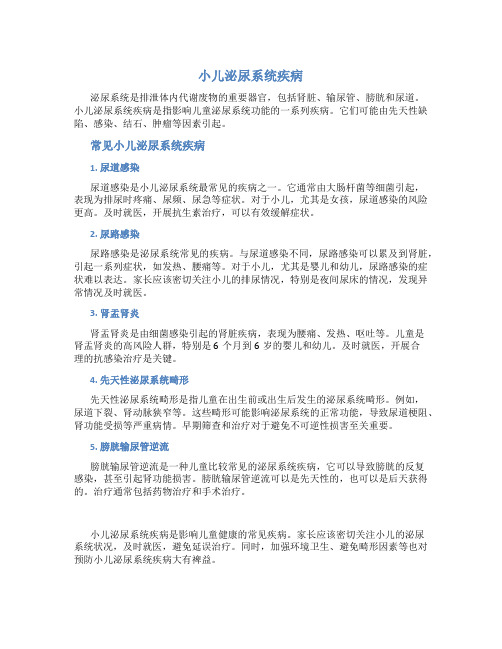
小儿泌尿系统疾病泌尿系统是排泄体内代谢废物的重要器官,包括肾脏、输尿管、膀胱和尿道。
小儿泌尿系统疾病是指影响儿童泌尿系统功能的一系列疾病。
它们可能由先天性缺陷、感染、结石、肿瘤等因素引起。
常见小儿泌尿系统疾病1. 尿道感染尿道感染是小儿泌尿系统最常见的疾病之一。
它通常由大肠杆菌等细菌引起,表现为排尿时疼痛、尿频、尿急等症状。
对于小儿,尤其是女孩,尿道感染的风险更高。
及时就医,开展抗生素治疗,可以有效缓解症状。
2. 尿路感染尿路感染是泌尿系统常见的疾病。
与尿道感染不同,尿路感染可以累及到肾脏,引起一系列症状,如发热、腰痛等。
对于小儿,尤其是婴儿和幼儿,尿路感染的症状难以表达。
家长应该密切关注小儿的排尿情况,特别是夜间尿床的情况,发现异常情况及时就医。
3. 肾盂肾炎肾盂肾炎是由细菌感染引起的肾脏疾病,表现为腰痛、发热、呕吐等。
儿童是肾盂肾炎的高风险人群,特别是6个月到6岁的婴儿和幼儿。
及时就医,开展合理的抗感染治疗是关键。
4. 先天性泌尿系统畸形先天性泌尿系统畸形是指儿童在出生前或出生后发生的泌尿系统畸形。
例如,尿道下裂、肾动脉狭窄等。
这些畸形可能影响泌尿系统的正常功能,导致尿道梗阻、肾功能受损等严重病情。
早期筛查和治疗对于避免不可逆性损害至关重要。
5. 膀胱输尿管逆流膀胱输尿管逆流是一种儿童比较常见的泌尿系统疾病,它可以导致膀胱的反复感染,甚至引起肾功能损害。
膀胱输尿管逆流可以是先天性的,也可以是后天获得的。
治疗通常包括药物治疗和手术治疗。
小儿泌尿系统疾病是影响儿童健康的常见疾病。
家长应该密切关注小儿的泌尿系统状况,及时就医,避免延误治疗。
同时,加强环境卫生、避免畸形因素等也对预防小儿泌尿系统疾病大有裨益。
儿童泌尿系统疾病教育课件

家长在面对孩子泌尿系统疾病时,应保持积极乐观的态度 ,给孩子传递正能量和希望,激发他们的康复信心和勇气 。
06 总结回顾与展望未来发展
本次课程重点内容回顾
01
儿童泌尿系统常见疾病及其症状
包括尿路感染、肾炎、肾病综合征等,以及尿频、尿急、尿痛等常见症
状。
02 03
诊断和治疗原则
针对儿童泌尿系统疾病的诊断方法和治疗原则进行了详细讲解,包括尿 液分析、影像学检查等诊断手段,以及药物治疗、手术治疗等治疗措施 。
治疗
手术治疗、药物治疗、对症治疗等,具体治 疗方案需根据病情制定。
D
诊断方法与治疗原则
03
临床表现及诊断依据
01
常见症状
包括尿频、尿急、尿痛、血尿、腰部疼痛等。
02
体格检查
注意腹部、腰部压痛、叩击痛,以及外阴部检查。
03
尿液分析
是诊断泌尿系统疾病的重要依据,包括尿常规检查和尿 沉渣镜检。
辅助检查手段介绍
治疗
抗生素治疗、对症治疗 、多饮水等。
肾小球肾炎
01
02
03
04
定义
肾小球肾炎是一种肾脏疾病, 主要表现为肾小球炎症和肾功
能损害。
症状
水肿、高血压、血尿、蛋白尿 等。
诊断
尿液分析、血液检查、肾脏B 超等。
治疗
药物治疗(如激素、免疫抑制 剂等)、对症治疗、饮食调整
等。
肾病综合征
定义
肾病综合征是一组以大量蛋白 尿、低蛋白血症、水肿和高脂 血症为主要表现的临床综合征
预防保健措施
强调了预防保健措施在儿童泌尿系统疾病中的重要性,包括合理饮食、 充足饮水、注意个人卫生等。
儿童泌尿系统疾病-精品医学课件
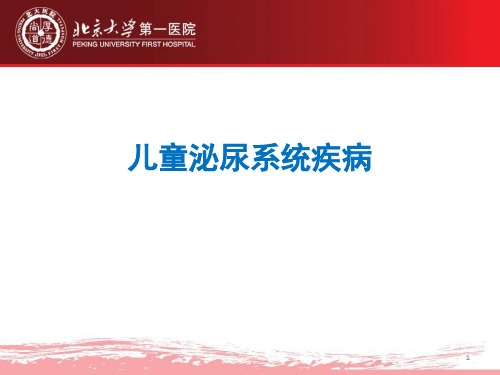
儿童排尿及尿液特点
• 排尿次数: – 生后4-5次/天 – 生后1周后20-25次/天 – 1岁15-16次/天 – 学龄前和学龄期6-7次/天
• 3岁能控制排尿 • 正常每日尿量
– 新生儿, 1-3ml/kg·h – (年龄-1)×100+400
• 少尿 (Oliguria) – 新生儿, <1ml/kg·h – 婴幼儿, <200ml/d – 学龄前儿童, <300ml/d – 学龄儿童, <400ml/d
中华医学会儿科学分会肾脏病学组(2000.11 珠海)
• 原发性肾小球疾病 (Primary Glomerular Diseases) • 继发性肾小球疾病 (Secondary Glomerular Diseases)
– 紫癜性肾炎(Purpura Nephritis) – 狼疮性肾炎(Lupus Nephritis) – 乙肝病毒相关性肾炎(HBV-associated Glomerulonephritis) – 其它:毒物、药物中毒,或其它全身性疾患
合征…… • 肾血管疾病: 肾动脉狭窄、肾静脉血栓、左肾静脉压迫综
合征…… • 尿路(输尿管、膀胱)疾病: 感染、结石、畸形、肿瘤……
17
小儿肾小球疾病临床分类
中华医学会儿科学分会肾脏病学组(2000.11 珠海)
• 原发性肾小球疾病 (Primary Glomerular Diseases) • 继发性肾小球疾病 (Secondary Glomerular Diseases)
• 遗传性肾小球疾病(Hereditary Glomerular Diseases)
– 先天性肾病综合征(Congenital Nephrotic Syndrome) – 遗传性进行性肾炎,即Alport综合征 – 家族性再发性血尿(Familiar Recurrent Hematuria) – 其它,如甲-膑综合征
小儿泌尿系统疾病课件

欢迎来到小儿泌尿系统疾病课件,我们将一起探索常见疾病、症状、诊断、 治疗和预防方法,以及家属支持和护理的重要性。
常见小儿泌尿系统疾病
1 尿路感染
2 尿失禁
常见于小女孩,尿频、尿急、尿痛是其主 要症状。
无法控制小便,尤其在夜间。
3 膀胱输尿管逆流
4 肾Байду номын сангаас能障碍
膀胱内尿液逆流,容易引起反复的尿路感 染。
小患者康复
看着他们快乐地玩耍,是我最 大的成就感。
家长的支持
家长的积极参与和关心对患儿 的治疗非常重要。
与家属合作
与家属密切合作,共同制定治 疗计划。
观察尿液流动的速度和压力 来评估尿路功能。
治疗方法
1
药物治疗
如抗生素、利尿剂和抗炎药,用于控
手术治疗
2
制感染、改善尿液排泄和减轻炎症。
对于一些重度的疾病,手术可能是唯
一的治疗选择。
3
行为疗法
如定时排尿、饮食调整和尿床闹钟, 有助于纠正不良的排尿习惯。
预防与注意事项
• 饮食健康:保持充足的水分摄入和均衡的饮食。 • 注意个人卫生:及时更换内衣、小便后正确擦拭。 • 避免尿憋积:尽量避免长时间憋尿。 • 尿床管理:使用尿床保护垫和培养孩子定时排尿习惯。
导致尿液排泄异常和肾脏疼痛,可能影响 生长发育。
疾病症状与表现
腹痛
孩子会抱着肚子,表现出不适 和疼痛。
背部疼痛
可能是肾脏问题的症状之一。
夜间尿床
持续尿床可能是尿失禁的表现。
诊断方法
尿液检查
通过检查尿液中的细菌、红 细胞和白细胞来诊断感染。
超声波检查
用于检查肾脏和膀胱的结构 和功能。
儿科泌尿系统疾病课件

重点
• 肾综的病理生理 • 单纯型与肾炎型的临床表现 • 肾综的治疗(重点激素治疗)
46
• 症状与体征 Symptoms & Signs • 并发症Complication • 感染infection • 低血容量休克shock • 电解质紊乱electrolytes imbalance • 血管栓塞thrombosis • 急性肾衰renal failure
33
(六)实验室检查 laboratory examination
△ 单纯型 simple Type NS △ 肾炎型 nephritic Type NS
8
(2)按糖皮质激素反应分 △激素敏感型 steroid - responsive NS △激素耐药型 steroid - resistant NS △激素依赖型 steroid - dependent NS △肾病复发与频复发 relaps and frequently relaps
• 尿常规,24小时尿蛋白定量 • 胆固醇,血浆白蛋白,血清蛋白电泳,
肾功能,血清补体,血沉等。
34
(七)诊断和鉴别诊断 diagnosis & differential diagnosis
1 诊断标准 • 大量蛋白尿 >2周,24小时尿蛋白总量
• 血浆白蛋白< 30 g/L • 胆固醇 <5.7 mmol/L • 水肿 2 临床分型
43
(九)预后 prognosis
• 单纯型预后比肾炎型好 • 取决于病理分型 • 激素耐药和非MCD型预后欠佳。
44
小结
肾综是肾小球滤过膜通透性升高, 大量血浆白蛋白从尿中丢失,而引起一 系列病理生理改变的一种临床症候群。 以大量蛋白尿,低蛋白血症,高脂血症, 不同程度水肿为特征。发病率高,小儿 时期以原发性肾综为主。
婴儿常见的泌尿系统疾病有哪些

病因与预防
病因
婴儿尿道感染的常见病原体包括大肠 杆菌、变形杆菌、葡萄球菌等,这些 病原体可能通过血液传播、上行感染 等方式引起尿道感染。
预防
家长应注意宝宝的个人卫生,勤换尿 布,保持会阴部清洁干燥;同时,合 理喂养,增强宝宝免疫力,也有助于 预防尿道感染的发生。治疗与护理治疗
针对婴儿尿道感染,医生通常会根据症状和病因选择合适的抗生素进行治疗, 同时会给予对症治疗,如多饮水、保持尿流通畅等。
婴儿常见的泌尿系统疾病
作者:XXX 20XX-XX-XX
contents
目录
• 尿道感染 • 膀胱感染 • 肾结石 • 肾积水 • 肾发育不全
01
尿道感染
定义与症状
定义
尿道感染是指尿道受到细菌、病 毒等病原体侵犯而引起的炎症反 应。
症状
婴儿尿道感染通常表现为排尿时 哭闹、尿频、尿急、尿痛等症状 ,有时还可能出现发热、食欲不 振等全身症状。
病因
肾积水的主要病因是尿路梗阻,可能由先天性发育异常、泌尿系统感染、结石等多种因 素引起。
预防
预防肾积水的主要措施包括保持婴儿排尿通畅,避免尿路感染,定期进行泌尿系统检查 等。
治疗与护理
治疗
肾积水的治疗应根据病因和病情的严重程度 制定,可能的治疗方法包括药物治疗、手术 治疗和保守观察等。
护理
在婴儿肾积水的治疗过程中,家长应密切关 注宝宝的病情变化,遵医嘱进行治疗和护理
,同时保持良好的生活习惯和卫生习惯。
05
肾发育不全
定义与症状
01
02
03
总结词
了解肾发育不全的定义和 症状是早期发现和治疗的 关键。
定义
肾发育不全是指肾脏在胎 儿期或婴儿期未能正常发 育,导致肾脏结构和功能 异常。
- 1、下载文档前请自行甄别文档内容的完整性,平台不提供额外的编辑、内容补充、找答案等附加服务。
- 2、"仅部分预览"的文档,不可在线预览部分如存在完整性等问题,可反馈申请退款(可完整预览的文档不适用该条件!)。
- 3、如文档侵犯您的权益,请联系客服反馈,我们会尽快为您处理(人工客服工作时间:9:00-18:30)。
急性链球菌感染后肾炎
Acute post-steptococcal glomerulonephritis(APSGN)
• 病因与病原菌
– 外因: A组β-溶血性链球菌致肾炎菌株感染
• 12型:呼吸道感染,约占51%,多发生在冬天 • 49型:皮肤感染,约占25.8%,多发生在夏天
– 内因:遗传背景(易感性)
• 免疫系统异常 • 补体系统缺陷
发病机理(APSGN)
链球菌感染 抗原进入体内
循环、原尿、蛋白尿 红、白细胞尿
各种管型
基底膜断裂 血液成分漏出
水肿、高血压 循环充血 急性肾衰竭
尿量减少 水钠潴留 血容量增多
毛细血管堵塞 肾血流量下降
GFR降低
膜攻击复合物、氧自由基 炎症介质、细胞因子
– 肾小球肾炎(glomerulonephritis):急性、急进性、迁延性、慢性 – 肾病综合征(nephrotic syndrome, NS):单纯性、肾炎型 – 孤立性血尿或蛋白尿(isolated hematuria/proteinuria)
• 继发性肾小球疾病(secondary glomerular diseases)
– 紫癜、狼疮、乙肝、毒物、药物
• 遗传性肾小球疾病(hereditary glomerular diseases)
– 遗传性肾病(先天性肾综?):芬兰型、法国型(弥漫性系膜硬化) – 遗传性进行性肾炎:Alport综合征 – 家族性再发性血尿(familial recurrent hematuria)/薄基底膜病。 – 其他,如甲-膑综合征。
– 蛋白尿:尿蛋白含量>150 mg/d,>100 mg/L,>4 mg/(m2·h),随意尿 的蛋白/肌酐(mg/mg)>0.2,或定性阳性。
– 血尿:新鲜尿离心后沉渣显微镜检查,红细胞>=3 个/HP。
儿童肾小球疾病的临床分类
• 原发性肾小球疾病(primary glomerular diseases)
Fig. Acute diffuse proliferative glomerulonephritis with considerable infiltration of the glomerulus by neutrophils. This exudative change is common in acute postinfectious glomerulonephritis. (PAS, x1000.)
• 掌握 – 急性肾小球肾炎的临床表现,实验室检查及治疗原则 – 肾综的病理生理、临床表现、诊断与临床分型、常见并发症、治疗原则
儿童泌尿系统解剖生理特点
• 儿童尿液特点
– 少尿、无尿:新生儿<1.0 ml/(kg·h)为少尿,<0.5 ml /(kg·h)为无尿。 学龄期<400 ml,学龄前< 300 ml,婴幼儿< 200 ml为少尿; < 50 ml为 无尿。
A glomerulus with endocapillary hypercellularity and closure of the glomerular capillaries. Because of the increased cellularity within each lobule, there is an accentuation of the lobularity. (HE, X400.)
系膜、内皮 细胞增生
肾小球病理改变
• 弥漫性毛细血管内增生性肾小球肾炎 • 特点:弥漫性、渗出性、增生性 • 光 镜:肾小球体积增大,内皮和系膜细胞增生,中性粒
细胞浸润 • 免疫荧光:沿毛细血管壁和系膜区有颗粒状C3和 IgG沉积 • 电 镜:电子致密物沉积,驼峰状
A
B
Diagrams depicting the ultrastructural features of a normal glomerular capillary loop (A) , and the ultrastructural features of APSGN (B), Note the subepithelial hump like dense deposits and endocapillary hypercellularity.
Silver stain of a glomerulus from a patient with PSAGN. Note that all the hypercellularity is confined within the glomerular tuft (endocapillary hypercellularity). (Jones silver methenamine, x600.)
Neutrophils infiltration
LM of a glomerulus with
APSGN demonstrating marked influx of
neutrophils (arrows, ×700.)
Fig. This glomerulus shows a broadening of the lobules, increase in cellularity with moderate numbers of PAS-positive neutrophils, and reduction of the capillary lumens. (PAS, x400.)
南方医科大学南方医院儿科 孙良忠
目的与要求
• 了解 – 小儿泌尿系统解剖生理特点,小儿泌感病因、诱因、临床表现、诊治 – 先天性肾病综合征、血尿的鉴别诊断、溶血尿毒综合征、乙肝相关性肾 炎、肾小管酸中毒
• 熟悉 – 小儿遗传性肾炎:Alport综合征(眼耳肾综合征) – 急性肾小球肾炎的病因、发病机制、鉴别以及肾病综合征的病因
急性肾小球肾炎(Acute Glomerulonephritis)
• 定义
– 急性起病,以血尿为主,伴不同程度蛋白尿、水肿、高血压 或肾功能不全为特点的临床综合征(急性肾炎综合征)
• 病因
– 感染性:细菌、病毒、真菌等。链球菌感染后肾炎最常见 – 非感染性:药物、毒物、免疫因素、全身性系统性疾病等
